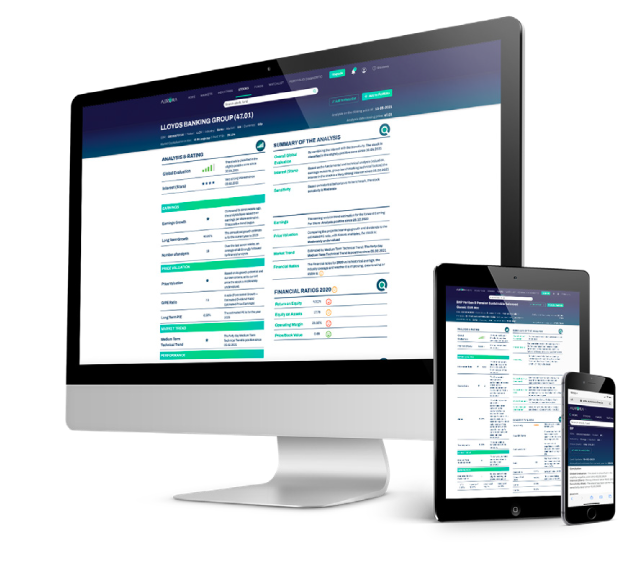
The Simplest, Most Intuitive Investment Research
Empower your investment ideas. Invest systematically. Save time and money.
40 markets, 100 industries, 6,000 stocks and 15,000 funds
Investing has never been simpler. Discover Investment opportunities, Track and analyse your portfolio and test your ideas, to help you meet your investment goals.
No Obligation Free Trial
What is Factor Investing anyway..?
Factor investing is all about putting data to work and developing a consistent, repeatable investment strategy based on solid metrics.
Instead of picking stocks or funds by drilling deep into the fundamentals of each asset, factor investing allows you to select which ‘factors’ are important to you, and to filter, refine, and sort, a galaxy of investment possibilities to identify the opportunities that deserve more of your attention.
…and what are the Factors?
Factors are the ‘building blocks’ of an investment strategy. Each factor is a characteristic that helps to explain the long term risk and return performance of an asset. It might include, for instance, measurements of how far a share is overvalued or undervalued, how a share price performs, estimates of future earning, growth forecasts, dividend payouts, movements in analysts’ estimates over time, and even how a share will react in falling or volatile markets.
Aurora DIY Investing takes the data on each factor to perform the kind of analysis which until recently has only been accessible to professional investors.
So you want to build a strategy?
Aurora’s intuitive interface makes it exceptionally easy to build strategies by combining factors that can help you identify stocks and funds in a systematic way. By saving multiple strategies and portfolios, you can observe their performance over time, refine them with further analysis, or look in-depth at individual opportunities.
- Select the Factors which are important to you. Valuation? Growth potential? Riskiness? Dividend earnings?
- Define specific attributes and combine with Aurora’s analysis.
- Choose country or region, industry or sector.
- Sort the filtered results in multiple dimensions.
- Save your settings for easy reference later.
- Create multiple portfolios for ongoing analysis.
- Analyse your portfolio with our diagnostic tool.
- Make adjustments as required and approve, then share with your broker to execute trades.
- Monitor and rebalance with updates and alerts twice a week,

The Factors that Matter
Designed to give a broad overview of an investment at a particular point in time, Aurora’s Global Evaluation Metric combines multiple factors which we outline in more detail below. These include fundamental and technical elements such as Valuation, Earnings Revisions Trend, Technical Trends and Group Benchmarking, along with sensitivity (Risk) ratings based on the “Bear Markets” and “Bad News” Factor Metrics. These factors are then visualised as a simple volume bar where indicates the best possible rating and
indicates the worst.
This metric incorporates several factors (each of which is outlined in more detail below) and includes:
- Earning Revision Trend
- Valuation Rating
- Medium Term Technical Trend and (Market Trend)
- 4-week Relative Performance > 1%
We assess performance against each of these metrics and award a 0 to rating.
This is an abbreviation for 7 week Earnings Per Share Revision. This column concerns the value of these revised earnings. A figure of 2.8 implies that the analysts, compared with seven weeks ago, have now revised and raised their estimates by 2.8%. On the contrary, a negative number means that the earnings were revised at a lower estimate.
If the earnings revision is between -1% and 1% the analysts estimates are neutral.
We use Peter Lynch’s valuation methodology to assess whether a stock is trading at fair value, premium (over-valued) or discount (under-valued). This method compares expected earnings increase + dividend yield with estimated multiplier ratio.
Based on this approach a ratio below 0.9 indicates that investors must pay a premium for the growth potential since the stock is more highly valued and if the ratio is above 0.9, the stock is undervalued.
“Since Lynch was always looking for strong growth companies he could not use the traditional Price Earnings ratios as means for valuation because the markets would often bid those stocks up on expectations. So he created a metric called PEG which stood for Price Earnings Growth. The idea was that if a company was growing at 15% per annum then 15 P/E was a reasonable price to pay for the stock. It’s a simple shortcut that ignores many macro fundamentals but that was precisely the point. It was used as a rough measure to make sure that the investor did not grossly overpay for a stock ( for example buying a stock at 50 P/E for a company that was growing at only a 10% rate).” – Boris Schlossberg, BK Asset Management
MT Tech Trend is a technical indicator which we use to provide an assessment of whether the market like an investment or dislike it. If it is positive it indicates that the market currently “likes” (or, is buying) the stock. If it is negative it indicates that the market currently “does notlike” (or, is selling) the stock.
This figure measures the performance of a STOCK relative to its national or regional index in the last 4 weeks).
This figure measures the performance of a FUND relative to its benchmark in the last six month.
This is the estimated annual growth rate of future earnings. It is normally projected over the next two to three years, and is expressed as a percentage.
The G/PE Ratio is the basis of our Valuation Rating (above) and is expressed as the estimated growth of future earnings (LT Growth) plus dividend in %, divided by the estimated future PE ratio (Long Term P/E).
Select from small, medium or large firms.
A dividend is a distribution of profits by a company to its shareholders when it earns a profit or surplus and Aurora lets you select what kind of level of dividend payment you want as an element of your factor-based strategy
Stock price movements are generally volatile and contain sensitivity that can result in a total loss. Based on their historical behaviour, we classify stocks by sensitivity level which are assessed solely relative to other stocks.
It should be noted that even Low Sensitivity stocks remain highly sensitive investments that can lose up to all of their value, and that past performance is no indication of current or future performance.
We determine Sensitivity by measuring the “Bear Market” Factor and the “Bad News” Factor against the benchmark and identify three levels:
- Low Sensitivity: In this case, the sensitivity indicators fall below the world reference average.
- Moderate Sensitivity: In this case, the sensitivity indicators are higher than the world reference average, but lower than the standard deviation.
- High Sensitivity: At which the sensitivity indicators are at levels higher than the standard deviation.
No Obligation Free Trial
What we offer
- An intuitive, user-friendly interface to keep things simple.
- Analysis and ratings for 40 Stock markets, 100 Sectors, 6,000 Shares and 15,000 Funds.
- Investment ratings and rankings of quality and risk, all based on our fully transparent methodology.
- Regular, twice-weekly updates of our ratings and analysis so you can stay informed.
- Independent Portfolio Analysis for the big picture on your investments.
- Totally independent. Consistent, objective research with no hidden motives, commissions or costs.
- An integrated, all-in-one service to save precious time and avoid having to shop around.
- A proven-track record based on 20 years of experience. Our technology is based on theScreener switzerland who provide research and analysis to thousands of institutions and millions of professional investors worldwide.
Pricing
About Aurora DIY Investing
AURORA is a powerful, accessible DIY investing tool for the research and analysis of stocks, funds and portfolios and was created by SDIS Global AG in Switzerland.
AURORA analysis and evaluations are powered by theScreener which has more than 20 years of experience in securities research and analysis and is used by some of the world’s leading investment managers and banks, supporting more than 10 million end-users each month.
The system provides financial information and data to help you identify investment ideas. However, we do not advise you or guide you about this or what products to purchase or sell – these decisions are yours only, and you should do your own analysis before making any investment based on your own personal circumstances.
SDIS and the system are not subject to regulation, and SDIS does not hold a license for investment advisory, investment marketing or investment portfolio management under any law.The content provided on the system is independent and not based or tailored to your personal circumstances, to your needs or for your purposes, and should not be relied on as an estimate of profitability or the suitability of an investment in a particular stock for any purpose. Past performance is not a guarantee of present or future performance. Investments may lose its full value.

